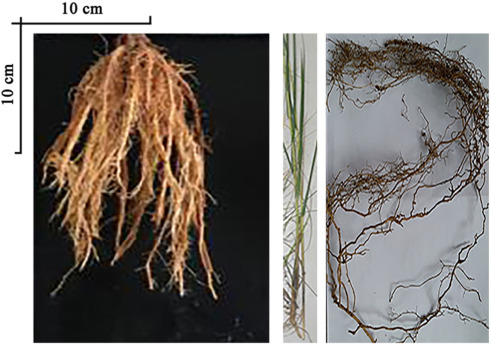Soil physical properties, infiltrability, and water flow behavior are closely associated with root morphology. However, the effects of roots with different morphometric features on water infiltration characteristics through soil have rarely been studied. Thus, the effects of roots on water infiltration behavior should be monitored and quantified.
Researchers from Xishuangbanna Tropical Botanical Garden (XTBG) conducted dye tracer experiments to assess the effects of roots with various morphometric features on soil water flow behavior and soil infiltrability. They selected three kinds of roots with various morphometric features (fibrous roots of maize, smooth roots of Spartina alterniflora, and fine roots of rubber tree) from three sites (Minqin, Dongtai, and Mengla).
They further wanted to reveal the ecological significance of water infiltration behavior in the three study sites where preferential flow is the dominant type of water flow.
The study found that water infiltration behavior, which is affected by the variations in the morphometric features of different roots, is crucial to water distribution.
In the Minqin site, fibrous maize roots provided the dominant path for preferential flow in furrows, whereas macropores provided the dominant path for preferential flow in the loose and fragmented soil structure of ridges. The fibrous roots of maize promoted even water flow across the plough layer.
In the Dongtai site, water infiltration was inhibited by the mud layer, subsequently resulting in ponding and surface runoff. The smooth roots of Spartina alterniflora induced water penetration through the mud layer, which has poor permeability.
In the Mengla site, portions of the moisture front propagated to significant depths while bypassing large areas of the matrix pore space. The fine roots of rubber induced water infiltration into deep soil layers.
The study entitled “Effects of three morphometric features of roots on soil water flow behavior in three sites in China” has been published in Geoderma.
Contact
LIU Wenjie Ph.D Principal Investigator
Key Laboratory of Tropical Forest Ecology, Xishuangbanna Tropical Botanical Garden, Chinese Academy of Sciences, Mengla, Yunnan 666303, China
E-mail: lwj@xtbg.org.cn

Different morphometric features of roots. Fibrous roots for maize in Minqin (left), smooth roots for S. alterniflora in Dongtai (middle), and fine roots for rubber in Mengla (right).
(Images by JIANG Xiaojin)

